For the past decade, I have been an advocate of vireyas, temperate rhododendrons from mountain areas in the
tropics, and have over the years established a collection of about 65 species and a comparable number of hybrids.
Although about 300 of the 900 species of Rhododendron are vireyas, in North America at least, vireyas as
a group are just now becoming more widely available and cultured. Because they do not tolerate freezing temperatures,
which occasionally occur where I live on Vancouver Island in British Columbia, Canada, I overwinter my vireyas in
greenhouses kept just above freezing. However, their diversity in size, flower shape and relatively frequent
flowering in comparison to the more hardy rhododendrons now make vireyas of particular interest to many keen
gardeners.
In the wild, most vireyas occur in the Malay Peninsula and islands eastwards, notably Borneo and New Guinea.
Relatively few occur northwards, although I was fortunate to go on a plant hunting trip (Bayes et al. 2006)
in 2005 to the Salween River valley in Yunnan, China, organized by Steve Hootman, Rhododendron Species
Foundation in Washington State, where I saw my first vireya in the wild, the tiny R. vaccinioides. In
late April 2008, I received approval to attend an oceanographic meeting three weeks later in Kota Kinabalu
(KK), the largest city and capital of Sabah, Malaysia, on the island of Borneo in south-east Asia. I arranged
to take a few days holiday before the meeting to partially explore the botanical biodiversity on Mount Kimbalu,
83 km to the north-east of KK, the highest mountain in SE Asia between New Guinea and the Himalayas, and the
habitat of many Sabah vireyas. The rhododendrons of Sabah have recently been described in new detail by Argent
et al (2007), and 26 are reported to occur on Mount Kinabalu, four of which are endemic to the mountain
(R. abietifolium, buxifolium, ericoides, and tuhanensis). This article describes my
recent experiences botanizing on Mount Kinabalu and its surrounding area (see Fig. 1 for location of Mount
Kinabalu on map).
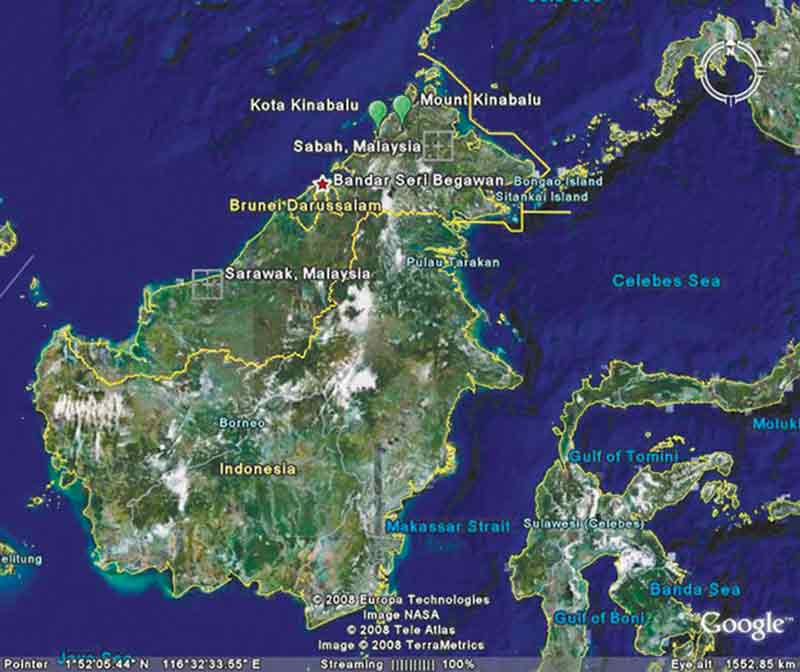 |
| Figure 1. Borneo and the location of Mount Kinabalu. |
Mount Kinabalu National Park, a designated UNEP World Heritage Site since 2000, has a regionally unique
biodiversity because of its high elevation range (152 - 4,095 m) and contains one of the richest and most
diverse assemblages of plants in the world. This is because the mountain covers a wide climatic range from
near sea level to freezing ground conditions near the summit, the jagged terrain and diversity of rocks and
soils (Takyu et al. 2002), the high levels of rainfall, and the past climatic instability caused by periods
of glaciation and catastrophic droughts (e.g., Kudo and Kitayama 1999) which encouraged evolution and speciation.
Most of Kinabalu's endemic species are found in the mountain forests, particularly on ultramafic soils (i.e.,
soils which are low in phosphates and high in iron and metals poisonous to many plants), where the high toxin
content has facilitated the development of distinctive plant species found nowhere else. Beaman and Beaman
(1998) noted that Kinabalu flora contains as many as 5,000 - 6,000 species, comprising over 200 families and
1,000 genera. It is believed to have more than 1,000 orchid species, including at least five species of slipper
orchids of the genus Paphiopedilum. In addition to the rhododendrons, other important plant groups
occurring in the Park include 608 fern species, nine Nepenthes (pitcher plant) species (including four
species endemic to Kinabalu), 78 Ficus species (over 50% of all the species found in Borneo), 52 palm species,
19 Begonia species, six bamboo species and 30 ginger species (UNEP 2008). Vegetative zones on the trails to
the summit are Upper Mountain Forest (1,900- 2,350 to 2,700 m), Ultrabasic Rock Forest (2,700-3,000 m), Lower
Granite Boulder Forest (3,000-3,300 m), Upper Granite Boulder Forest (3,000-3,800 m) and Summit or Subalpine
(3,200-4,095m). The upper boundaries of the lowland, upper montane and subalpine zones coincide with thermal
thresholds of latitudinal bioclimatic zones (Kitayama 1992): 18°C TMIN (Kippen's tropical), WI 85 (Kira's
warm temperate), and WI 45 (Kira's cool temperate), respectively. These climatic characteristics appear to
define ecological altitudinal turnover points, so called "critical altitudes," where groups of associated
species are displaced by other groups.
The physiogeography of Mount Kinabalu is the result of volcanic, tectonic and geological processes that
occurred over 1.5 million years ago (UNEP 2008). Mt. Kinabalu itself is a plutonic intrusion (magma that
solidified underground before reaching the earth's surface) surrounded by metamorphosed and Tertiary
sedimentary rocks. Rapid uplift followed by glacial erosion during the Ice Age accompanied by further
geological activities has sculpted the mountain: the summit area of the mountain (above 3,200 m) displays
the effects of glacial activity in the shape of "nunataks," or jagged peaks (such as Low's Peak and South
Peak); other areas show signs of striations, grooves and polished surfaces, as well as the creation of
cirques and deposit of glacial moraines; and U-shaped valleys and gullies are present in the park, as well
as "roche moutonn's" ("sheep-like rocks," rounded masses of rock smoothed and striated by glacial ice
that has flowed over it). Ultrabasic intrusive, granite and sedimentary rocks are present, acting as
parent material for eight soil associations.
Mount Kinabalu's summit was first conquered by Colonial Secretary of British Labuan, Hugh Low in 1851.
The native Dusuns who resided in the foothills of Kinabalu and the surrounding Crocker Range did not
reportedly climb the mountain for fear of disturbing the resting place of the spirits of their departed
ancestors. In the early years prior to each climbing expedition, the Dusuns who served as guides and
porters would perform rituals and sacrifices to appease the spirits and to seek safe passage. Nowadays,
the frequency of these sacrificial rituals has been reduced to once a year and the practices include the
sacrifice of seven white chickens at the summit. Since 1994, the number of climbers has exceeded 30,000
per year, and for adventurers, climbing Mount Kinabalu in SE Asia is somewhat akin to climbing Mt.
Kilimanjaro in Africa.
The park has a humid tropical climate typical of the region, with temperature, humidity and rainfall
varying with altitude. February to May are generally the driest months, although I was told that in
recent years, the dry season now seems to extend into July and August, while October to January are
the wettest. At Park Headquarters (1,560 m) the mean monthly temperature is approximately 20°C, with
a daily fluctuation of about 7 - 9 °C. Mean annual rainfall at this location is about 2,380 mm
(Kitayama et al. 1999). Common climatic features of the park are bright early mornings, followed
quickly by clouding mid-morning, which obscures the mountains by mid-day. Showers usually occur on
the upper slopes in the afternoon. In some years there are periods of prolonged dry spells,
relating to the occurrence of the El Nino Southern Oscillation. This has severe effects on the
park's vegetation (Lowry et al. 1973, Kudo and Kitayama 1999).
Having never before been to Malaysia, and with no contacts there, the first thing I did in
arranging my trip was to email Dr. George Argent, Royal Botanic Garden, in Edinburgh, Scotland,
to ask him for his advice on how best to proceed. He responded quickly, and suggested I
contact both Ansou Gunsalam, the senior Kinabalu National Park naturalist in Mesilau, and Tony
Lamb, who has lived in Kota Kinabalu for almost 40 years, was one of the co-authors of Argent
et al. (2007) and who has a vast wealth of local knowledge on the botanical diversity of
Sabah's mountain areas. I found a general email address for the national park, and sent an email
there explaining my interest and date of arrival, and asking that it be forwarded to Ansou. Tony
does not have an email address, and although I had his phone number, decided to wait till I
arrived in Sabah before contacting him, as I understood he was very busy and would likely be
difficult to contact.
George indicated that when he was last in Sabah, he found that going up Kinabalu was not as
easy as it used to be, since Sabah Parks had now "privatized" all the tours and accommodation on
the mountain. He stated he had a terrible time trying to book accommodation on short notice, so my
first priority was to try to arrange accommodation on the mountain. Using the internet, I quickly
found out that all direct bookings had to go through Sutera Sanctuary Lodges. Following a series of
email exchanges, and noting that Ansou was based in Mesilau and not at the more popular Kinabalu
National Park Head Quarters location (Timpohon Gate), I was subsequently able to book my first and
third night in a hostel at the Mesilau Nature Resort (2000 m), my second night in the hostel at
Latan Rata (3250 m, the staging area in the lower alpine for climbers going to the mountain peak),
and my fourth night in the hostel at Poring Hot Springs (550 m), about 40 km away in a more
subtropical area lower on the mountain. All four night's accommodation was shared accommodation
in bunk-bed rooms with potentially five to seven other travelers. As it turned out, on two of the
nights, I had the entire eight-bed rooms to myself, and the only night all the beds were filled was
at Latan Rata!
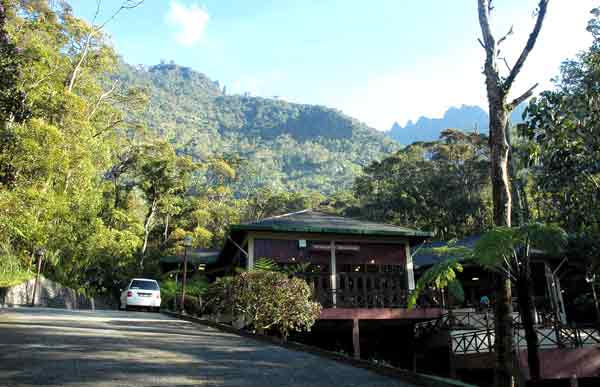 |
| Figure 2. The Mesilau Lodge
reception area and restaurant, with the lower ridges of Mount Kinabalu in the background. Photo by Glen Jamieson |
I flew from Vancouver to Hong Kong on May 14, where a 10-hour layover gave me the opportunity to leave the airport and explore both Kowloon and Hong Kong Island. As I was arriving in KK from Hong Kong late in the evening, I pre-booked a hotel reservation at the D'Borneo Hotel in KK, which was conveniently located downtown near the inter-city bus stops. The intercity bus trip from KK to Kundasang, about 5 km past Kinabalu Park HQ, the next morning left at 8:30 a.m., took about two hours (130 km), but arriving there, I found there was no public transportation to Mesilau Nature Resort (see Fig. 2), which was about 13 km away up a smaller road. A local driver offered to take me, but after arriving, there was confusion over the price - being perceived as a likely wealthy tourist, he asked for more than I was willing to pay, but we finally agreed on an acceptable price. The accommodation in the hostel at Mesilau was very nice, and on arrival, I was fortunate to meet Ansou at the Park Nature Centre, who as it turns out only receives emails infrequently, and had just received mine the day before. He was very helpful, and arranged for his colleague Sukaibin Sumail, a younger but also very knowledgeable park naturalist, to guide me on the mountain for the next two days and help in plant identification. A park climbing permit and guide hire are required. Ansou then took me on a nearby protected trail to see Nepenthes, where I was fortunate to see four species, including the world's largest, the very impressive N. rajah (see Fig. 3), and my first Sabah vireya, R. crassifolium.
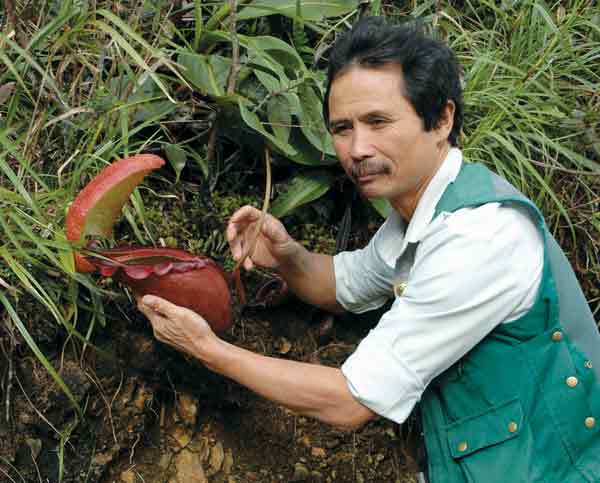 |
| Figure 3. Ansou Gunsalam with a
medium-size Nepenthes rajah pitcher. It is ground-dwelling in open areas, as large pitchers, when filled with up to 3.5 l of water, are too heavy to be suspended. Photo by Glen Jamieson |
That night, the weather deteriorated, as the remains of Typhoon Nargis, which had devastated Myanmar (Burma) about a week earlier, had now settled over Sabah, producing 40-50 km winds and periods of heavy rain. Nevertheless, Sukaibin and I started up the Mesilau trail to Latan Rata the next morning on our quest for vireyas and other interesting plants. This trail to the lodge is less used by hikers, as it is 8 km long, 2 km longer than the more popular Summit Trail from Timpohon Gate. The Mesilau Trail goes up for about 2 km and then down for 1.5 km, and then up again for about 2.5 km to join the Summit Trail at Layang-Layang (Carson's Camp), its 4 km point (2750 m), with a further 2 km climb to the alpine lodges (3250 m). However, it is the desired trail for botanizing, as it goes through more ecological zones and thus has a greater biodiversity. Many parts are steep and slippery, but it has some spectacular views of waterfalls and the mountain above. After reaching the first ridge, which offers views of the Mesilau resort below, the trail descends through a fascinating forest, with many orchids, rhododendrons, mosses, liverworts and bamboos (the latter exhibit a bewildering range of forms - some are erect, others clambering to scrambling and others are climbers) and crosses little streams before reaching the Kipuyut suspension bridge across the tumultuous West Mesilau River (2075 m). From here the trail follows a ridge, rising almost continuously until it meets the Summit Trail, which it turn also rises continuously.
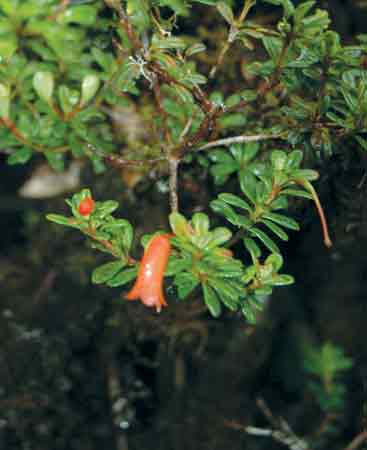 |
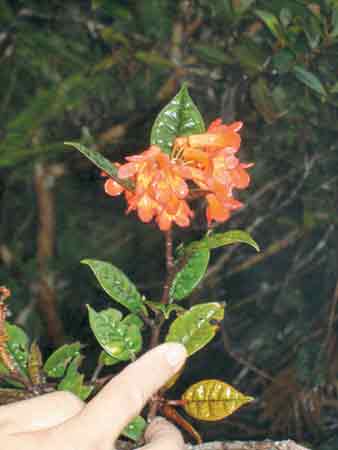 |
|
| Figure 4. R. cuneifolium v.
cuneifolium Photo by Glen Jamieson |
Figure 4. R. acuminatum Photo by Glen Jamieson |
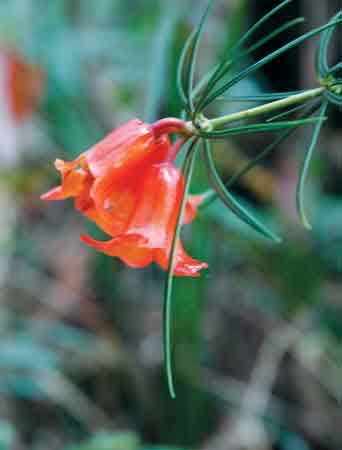 |
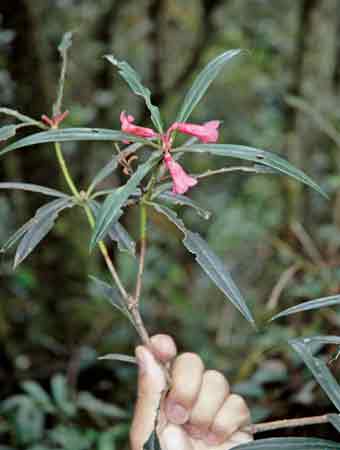 |
|
| Figure 4. R. stenophyllum v. stenophyllum (top flower damaged). Photo by Glen Jamieson |
Figure 4. R. xliewianum (natural R. rugosum x R. stenophyllum hybrid). Photo by Glen Jamieson |
The trail up to about 2600 m goes through the upper part of the lower montane oak-chestnut vegetative zone, which is dominated by over 40 species of tropical oaks (Quercus and Lithocarpus sp.), chestnut (Castanopsis sp.), and laurel (Lauraceae) reaching 25-30 m tall. The next 400 m or so of elevation is cloud forest, with many eucalypts and conifers, such as Podocarpaceae (Dacrydium, Podocarpus, Phyllocladus and Dacrycarpus) and Araucariaceae (Agathis). At about 2600 m elevation, the trail passes through a bamboo forest, where Miss Gibb's bamboo (Bambusa gibbsiae) drapes the trees like moss. Miss Lilian Gibbs, from the British Museum, was the first botanist, and woman, to ascend Kinabalu in 1910. She was a prolific collector of plants and brought back to England about 1000 plants, of which 87 proved new to science. The forest structure during the climb is largely determined by altitude, but differences in soil, exposure, and water availability create microscale habitat variation at any level. The recognized vegetation community around the alpine lodges is "tropical alpine ericaceous thicket."
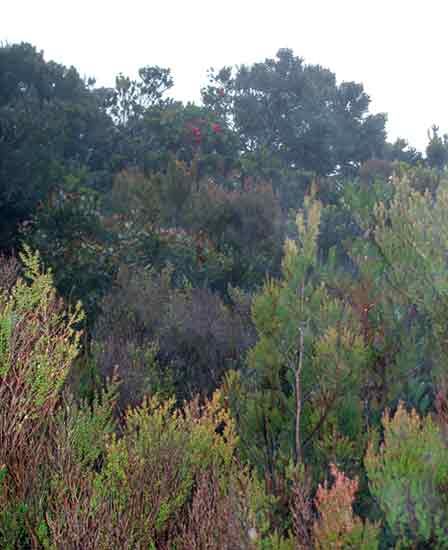 |
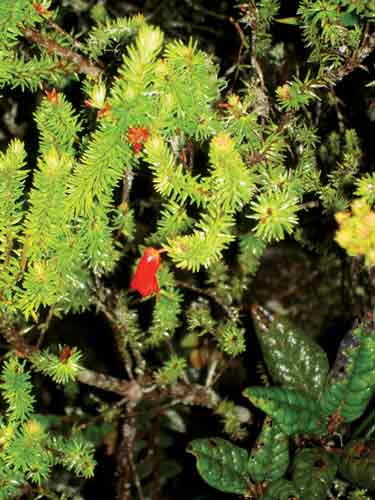 |
|
| Figure 5. Tropical alpine ericaceous thicket
in the rain, with R. ericoides in the foreground and R. buxifolium (red) high in the background. Photo by Glen Jamieson |
Figure 5. R. ericoides flower
and R. rugosum (another form). Photo by Glen Jamieson |
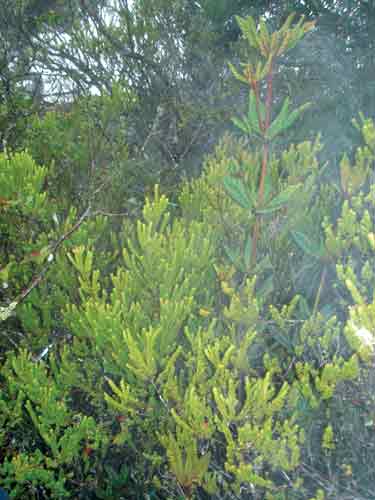 |
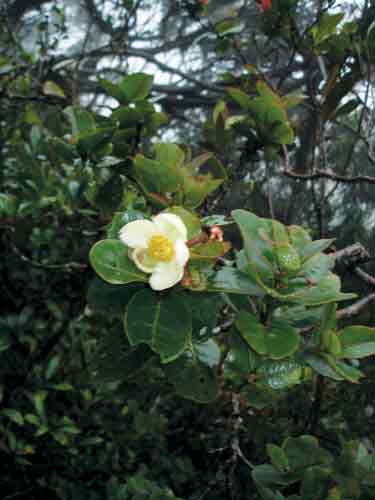 |
|
| Figure 5. R. ericoides and
R. rugosum. Photo by Glen Jamieson |
Figure 5. Schima brevifolia
(Theaceae) flower. Photo by Glen Jamieson |
The first flowering vireya we saw on the Mesilau trail was R. fallicinium (see Fig. 8), the commonest of the densely scaled Malayovireyas in Sabah, with nice reddish-orange flowers. The plants were often 4-5 m high, meaning you had to look up from the rough trail to see them, and were frequently first noticed by the dropped flowers lying on the trail from the flower heads above. This was quickly followed by sightings of R. cuneifolium v. cuneifolium (see Fig. 4), previously known as R. quadrasianum v. cuneifolium); R. stenophyllum v. stenophyllum (see Fig. 4), distinctive because of its narrow, linear, dark green leaves and orange flowers; R. nervulosum, similar to R. stenophyllum but with leaves about twice as wide; R. xliewianum (see Fig. 4), a natural R. rugosum x R. stenophyllum hybrid, which looks like R. nervulosum but with pink flowers, and according to George Argent, this was the first sighting of this hybrid on the Mesilau trail; R. acuminatum, with its coarsely veined, wrinkled leaves and orange-red flowers (see Fig. 4); R. rugosum (see Fig. 5), with its also coarsely veined, wrinkled leaves but pink flowers, and above about 3000 m, the heather-like R. ericoides and the large-red-flowered R. buxifolium (see Figs. 5, 6). We also saw the large yellow-flowered R. lowii (see Fig. 8), the largest individual flowers of any Sabah rhododendron) and R. retivenium (more slender leaves than R. lowii), but the latter was not flowering on the Mesilau trail.
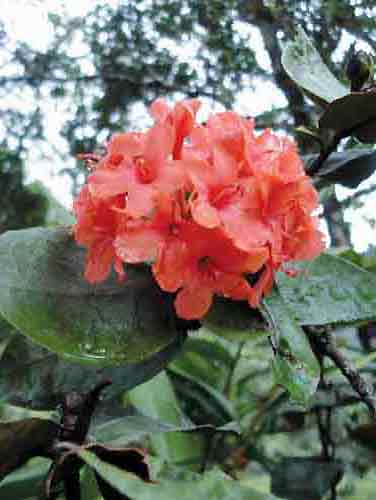 |
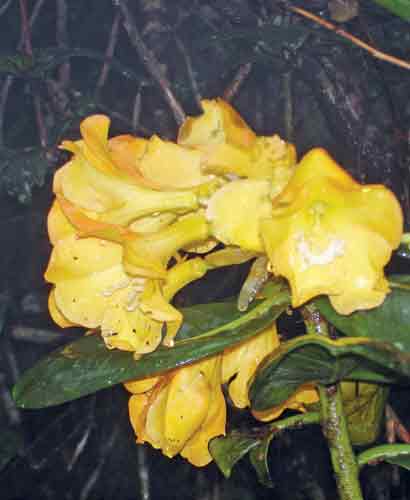 |
|
| Figure 8. R.
fallacinium Photo by Glen Jamieson |
Figure 8. R.
lowii. Photo by Glen Jamieson |
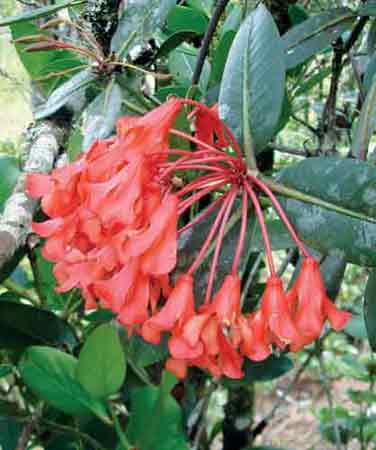 |
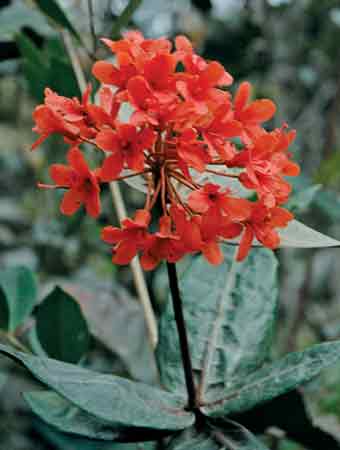 |
|
| Figure 8. R.
crassifolium Photo by Glen Jamieson |
Figure 8. R.
fallacinium (another form). Photo by Glen Jamieson |
Weather conditions really deteriorated after we joined up with the main Summit Trail, and the last 2 km were in periodic squalls, cloud and in exposed areas, strong winds. The temperature at the altitude of our lodge, which is largely unheated, was 7°C., but with the wind chill considered, conditions felt below freezing. I suffered both mild hypothermia and dehydration, but the social atmosphere among the 140 of us gathered inside the lodge was very friendly and lively, as we were all struggling to get warm and talk about our experiences on the climb up. An average ascent rate seems to be about one km/hr, and for Sukaibin and me, because of our frequent stops to photograph and talk about plants, and for me, occasional rests more frequent than I like to admit (in part because I had just had a six-week left leg cast from my knee to my toes removed five days earlier), the ascent from Mesilau took 8.5 hr.
 |
| Figure 7. The author descending
at about 2700 m on the Summit Trail in rain and cloud. |
It turned out that like the previous three nights, weather conditions were unfortunately so bad that all final ascents to the peak of Mount Kinabalu were cancelled that night, so those that got up at 3 a.m. hoping to climb and be at the peak at dawn were terribly disappointed. They had to return to their beds, and then descend the next day, as the lodge was again full the next night with new climbers and there was thus no room for people to stay on. However, since my objective was simply to botanize and not climb to the actual peak, I was not affected, except that the rain and wind made photography more difficult. On another visit, I will try to summit, though, just to say I had done it! We started down from Latan Rata to the Timpohon Gate, to maximize opportunity to see new areas, at 7:45 a.m. on May 16, with heavy rain and cloud again at higher altitudes (see Fig. 7). Conditions improved as we got lower, with quite nice weather at the bottom, where we arrived at 1:15 p.m. Being refreshed, we had more time on the way down to observe the higher altitude rhododendron species, R. ericoides, R. buxifolium (see Figs. 5, 6), R. lowii (see Fig. 8) and R. acuminatum (see Fig. 4), and Leptospermum recurvum, which was also dominant with vireyas around the lodge. At mid-elevation, we frequently saw R. cuneifolium v. cuneifolium (see Fig. 4) and R. rugosum (see Fig. 5), and the occasional R. javanicum. R. crassifolium was in flower at Mesilau (see Fig. 8). One of my observations was that most of the vireyas were ground-dwelling, and Sukaibin suggested that on Mount Kinabalu, vireyas were typically epiphytic only when the soil was clay. It should also be noted that the environment on most of the mountain where vireyas were observed was very wet, from both rain and cloud condensation, showing that for culture at least of the vireyas observed, watering can be quite frequent for optimum culture if the growing media is loose and drains well.
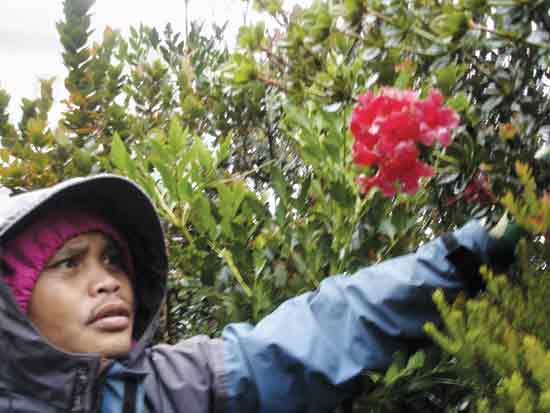 |
| Figure 6. Sukaibin Sumail
with R. buxifolium truss. Photo by Glen Jamieson |
From the Timpohon Gate, we took a taxi back to the Mesilau Lodge and the Kinabalu Park
Naturalist Centre, where I spent another night. Sukaibin had arranged transport for me
the next morning to Poring Hot Springs, 40 km away around the mountain and at an
elevation of 550m. The area there is subtropical, too warm for vireyas, but what can
be generally found there are flowering Rafflesia keithii (see Fig. 9), which as
a genus has the biggest flowers in the world, up to 80 cm in diameter (Salleh 2007).
Rafflesia have neither roots, leaves nor stem, and the only non-floral parts
are fine microscopic threads that pervade the roots and stems of host vines of
Tetrastigma, a genus in the grape family (Vitaceae). I was fortunate
in seeing three flowers, as each flower only lasts a few stays before starting to
show signs of deterioration. The flowering period is only for about 3 months of the
year.
After a nice soak in the hot springs, a welcome opportunity to sooth my tired
legs after the climb and descent of the past two days, I took the canopy walk, a 158
m walk in the canopy of Menggaris trees (Koompassia excelsa, up to 75 m high,
is the tallest tree in Borneo) 41 m above the forest floor, and wandered through
the extensive orchid collection there, although relatively few plants were flowering,
possibly because of the low light resulting from the heavy shade cloth over most of
the collection.
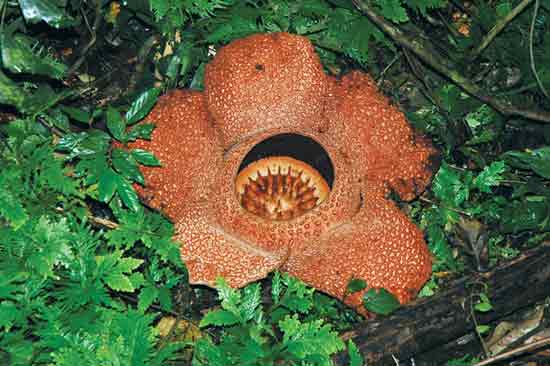 |
| Figure 9. Rafflesii
keithiiflower
at Poring Hot Springs, Sabah Photo by Glen Jamieson |
The next morning, I took a taxi to the main highway at Renau, where I caught the intercity bus back to KK, leaving me sore and tired but having very much enjoyed my brief visit to Mount Kinabalu. My final experience was to be able to meet Tony Lamb, and through him, Datuk Chan, Managing Director of Natural History Publications (Borneo). Both these gentlemen are a wealth of information about plants in Sabah, and provided me with both species identifications and advice on how to maximize opportunity on a future botanizing expedition in Sabah. I am looking forward to further discussions with them to avail myself of their knowledge and experience. Finally, I cannot conclude without stating how wonderfully friendly and helpful the Malaysian people are. Strangers I met in the hostels took me out to dinner and shared their food and beer with me, and everyone I met, from locals in the street to those in the tourist industry, was extremely friendly and when needed, helpful. I can't emphasis strongly enough what a pleasant place Sabah is to visit.
Acknowledgements
I am very grateful for all the assistance both Ansou Gunsalem and Sukaibin Sumail
of Sabah Parks provided me on my visit to Mount Kinabalu. My trip was greatly
enriched by their collective extensive knowledge and experience. Dr. George
Argent and Tony Lamb were very helpful in providing advice on trip logistics and in
confirming plant identifications.
References
Argent, G, A. Lamb, and A. Phillipps. 2007. The Rhododendrons of Sabah,
Malaysian Borneo. Kota Kinabalu: Natural History Publications: 280 pp.
Bayes, D., L. Bayes, M. Berg, L. Goetsch, S. Hootman, G. Jamieson, B. Macdonald,
B. McMillan, S. Nelson, S. Rafferty, G. Richardson, J. Smith, G. Wedemire, and
K. White. 2006. Plant hunting in Yunnan, China, 2005. J. American Rhododendron Soc.
60(2): 74-83.
Beaman, J.H. and Beaman, R.S. 1998. The Plants of Mount Kinabalu 3. Gymnosperms and
Non-orchid Monocotyledons. Natural History Publications (Borneo) Sdn. Bhd., Kota
Kinabalu, Sabah Malaysia and Royal Botanical Gardens, Kew.
Kitayama, K. 1992. An altitudinal transect study of the vegetation on Mount
Kinabalu, Borneo. Plant Ecology 102: 149-171.
Kitayama, K., M. Lakim, and M.Z. Wahab. 1999. Climate Profile of Mount Kinabalu
during late 1995 - early 1998 with special reference to the 1998 Drought. Sabah
Parks Nature Journal. Vol. 2: 85-100.
Kudo, G.and K. Kitayama (1999) Drought effects on the summit vegetation on
Mount Kinabalu by an El Nino event in 1998. Sabah Parks Nature Journal
2: 101-110.
Lowry, J.B., Lee, D.W. and Stone, B.C. 1973. Effects of drought on Mount
Kinabalu. Malay Nature Journal. 26: 178-179
Salleh, K.M. 2007. Rafflesia. Natural History Pub. (Borneo), Kota
Kinabalu: 48 pp.
Takyu, M., S. Aiba, and K. Kitayama (2002) Effects of topography on
tropical lower montane forests under different geological conditions on
Mount Kinabalu, Borneo. Plant Ecology 159: 35-49.
UNEP2008. UnitedNationsEnvironment program, Mount Kinabalu Natural
World Heritage Site proposal document. http://www.unep-wcmc.org/sites/wh/kinabalu.htm
Glen Jamieson is a member of the Mount Arrowsmith Chapter and the newly chosen editor of the Journal American Rhododendron Society